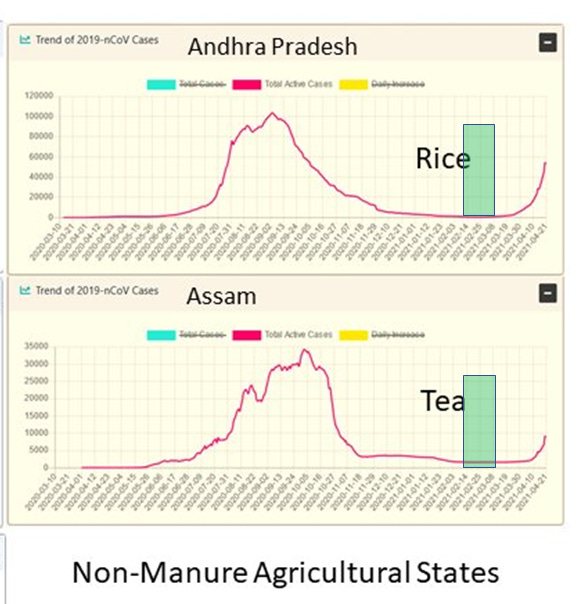Biosolids, fertilizer, and COVID (ewww...)
One of the more interesting (and smelly) theories of COVID spread
One of the most overlooked (and disgusting) possible vectors for spread of COVID is largescale use of Class B biosolids to fertilize fields. People nearby (and not-so-nearby-but-downwind) are likely to be infected with c19. Animals too!
First, what is a biosolid?
Often used as fertilizers, biosolids are the organic residues resulting from the treatment of commercial, industrial, and municipal wastewater (sewage).
In short, biosolids are treated sewage (including human waste) that have been processed to try to reduce the presence of pathogens.
Class A biosolids (theoretically) have been so thoroughly decontaminated that they require no special handling (no gloves, etc). (I say ‘theoretically’ because mRNA viruses - like COVID - have been found in Class A biosolids.)
Class B biosolids have had their pathogens ‘reduced’, but not eliminated. Using this type of sludge requires special protective equipment.
Note that not only can users put pathogenic Class B human sewage onto their land (and into their air) the CDC has specific guidelines telling them how to do so: “These require additional measures to restrict public access and to limit livestock grazing for specified time periods after land application [40 CFR Part 503]. This allows time for the natural die-off of pathogens in the soil.”
Second, it is well established in the literature that COVID viruses can live in human waste for some time - and can be quite infectious.
This mechanism has been blamed for rapid case spread in locations as diverse as Wuhan high-rise apartments and in nursing homes. One of the more famous incidents was spread to other people up to eleven floors apart in a Hong Kong apartment building, mostly in the floors above the infected resident; the mechanism was found to be outgassing from a poorly designed sewage system.
Put #1 and #2 together and you get the distinct possibility that farmers (and others) are aerosolizing active COVID virus particles while they fertilize their lands.
#1
There is considerable overlap between the areas in the Midwest that have lots of corn production (and associated use of biosolid fertilizers) and COVID rates in November 2020.
I consider this evidence weak, but suggestive - and it fits with the more concrete evidence below.
It also helps to explain why certain regions of the Midwest don’t follow classic Hope-Simpson seasonality.
#2
Many of you know that whitetail deer were discovered to be a major carrier (animal reservoir) of COVID. [These animal reservoirs are a major reason that vaccines will never end the pandemic - but that is a story for another time.]
A recent paper by Suresh, et al. 2021 attempted to correlate the rise in c19 positivity in Iowan deer with hunting season (i.e., they were trying to show that deer caught the virus from the hunters).
However, a better explanation may be biosolids.
One of the normal application periods for Class B biosolid fertilizer (again, including human sewage) is in the fall after harvesting corn and soybeans (late September - October). I marked this period of spraying biosolids on the figure from their paper (below) with a green box.
As you can see, this ‘aerated poop’ event fits the timeline (i.e., onset of the rapid rise of covid-positive deer) far better than does hunting season.
There are two additional reasons that hunters are VERY unlikely to be infecting these deer.
First, hunters don’t get close enough to deer that survive to infect them. In fact, I would safely guess that the only deer that get closer than 50 feet to a hunter are the ones that end up as venison, not disease vectors.
Second, other states and areas that have similar hunting seasons, but that do not use biosolids as fertilizer (e.g., the southwestern and southeastern states), do not have deer that test positive for covid.
#3
Evidence from the top eight agriculture-production states in India is more convincing.
Six of the eight use human sewage as fertilizer while the other two do not. They all fertilize between February 15th and March 15th, however the rate of increase in COVID case rates in the spring was dramatically higher in the six human biosolid users.
First, look at the case numbers from the two states that don’t use human sewage (green box again marks time of fertilizer programs).
Moderate, but not massive case spikes can be seen… and those rises come 5-6 weeks after the onset of the fertilizer period.
Now, the six that use human waste:
Not only do each of these case numbers spike higher…. the onset of the rise comes a bit earlier (2-4 weeks after fertilizer onset).
The size and timing of the spike is highly suggestive that the causative agent is biosolids.
Is all this proof? No. It is hardly more than an idea - barely a hypothesis….
But, it may also be good reason for vulnerable individuals to avoid vault toilets and port-a-potties.
Plus, it seems wise in general to propose that we not spray ‘fertilizer’ filled with a nasty pathogen (that is known to spread by aerosols) into the air!
Not to mention…. it is just disgusting.








Huge surge in rural California (but not urban centers). Guess what they just did in these areas??? (Hint: read the above post). https://www.latimes.com/california/story/2021-11-13/la-me-san-joaquin-valley-covid-surge